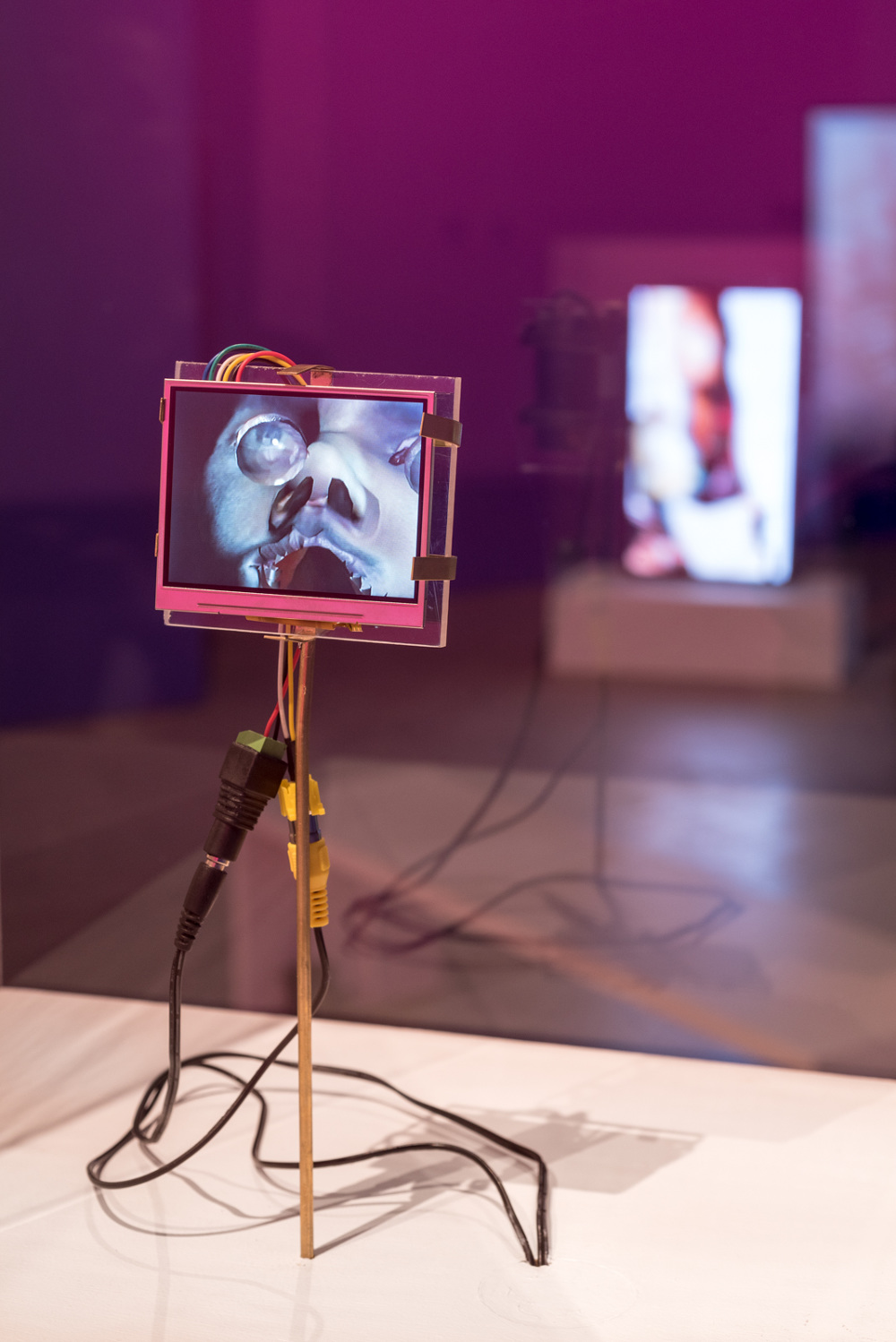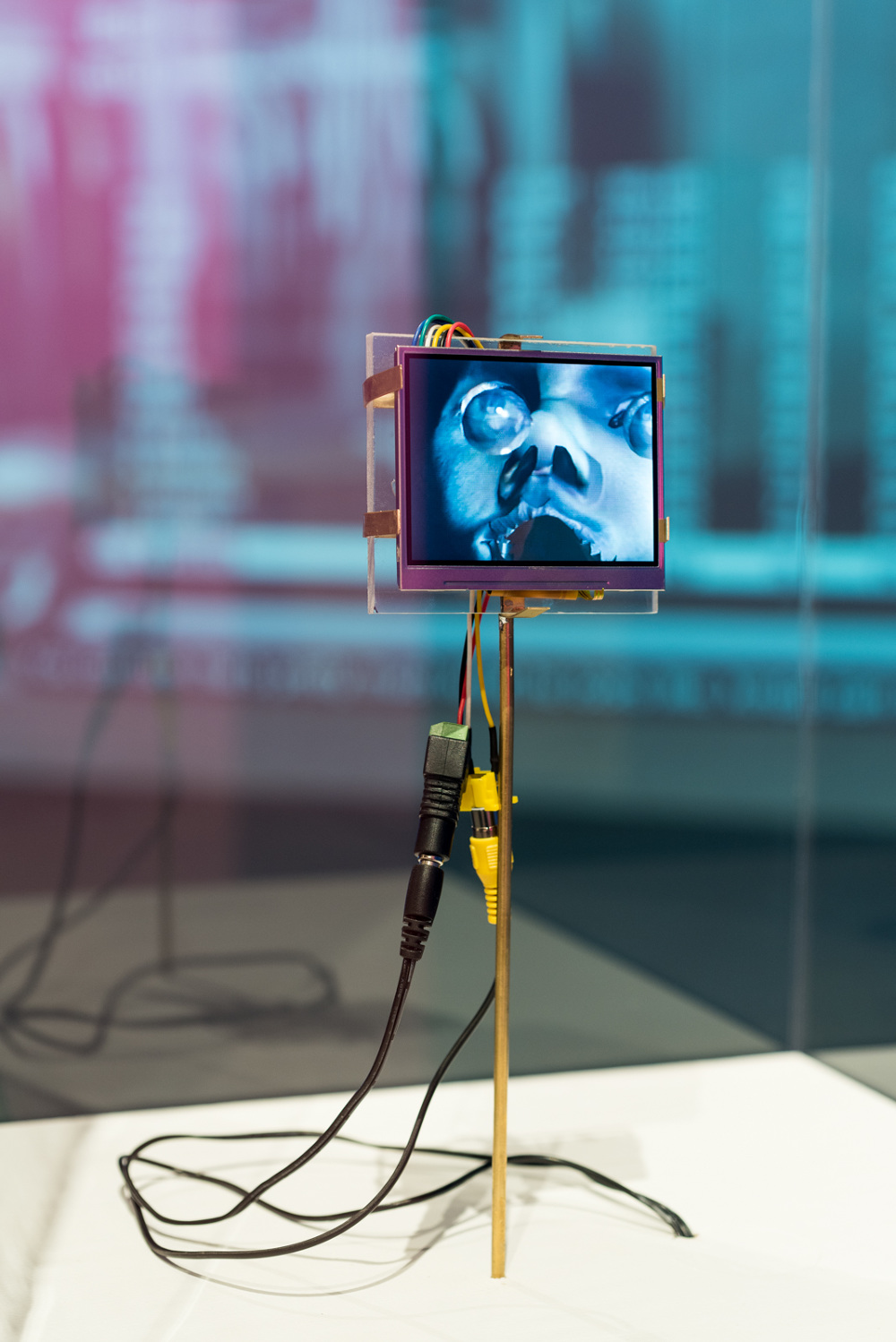Multimedia artist Sondra Perry‘s most recent exhibition at the Bridget Donahue Gallery speaks to the larger thematic explorations that tie all her work together – the exploration of digital technology and identity. The installation titled IT’S IN THE GAME ‘17 or Mirror Gag for Vitrine and Projection, 2017 is centred around the projection of a video within a room painted Rosco Chroma Key Blue.
The video begins with blurry images of Sondra and her twin brother when they were young. Rotating in the middle are what look like a 3D scans of alternating sculptures coloured in blue. A distorted version of the song ‘You Are Everything’ by the Stylistics plays, creating a somber, mournful mood. Two minutes in, a paused moment in a basketball videogame appears on the screen. The screen rotates around the players in the game, and two smaller videos come to view. The one video shows Sondra’s brother looking at “artefacts” in a museum’s collection of African, Oceanic, and American art. The other video shows the museum from Sondra’s perspective. The fast-paced beating of drums switch the mood to one of urgency. Sondra and her brother are seen taking photographs from a close range, and scrolling through information on their phones, as if taking notes for a strategic operation. A revolutionary one perhaps.

Suddenly what sounds like a computer generated voice breaks the sound of the music. It tells the history of the “objects” housed in the glass cases seen in the museum. This digitized narrator echoes the cold, detached and uncontexualized manner in which these “objects” have been displayed, mimicking the way in which they were taken from their places of origin.
During this commentary we see Sondra photographing her brother on a basketball court. This references the way in which people of colour and their cultures have been objectified, quite literally. It also references the fact that her brother, an NCAA basketball player, discovered that a videogame was created and included him as a player without his knowledge or consent.

The colour of the walls plays a significant role in the installation. Rosco Chroma Key Blue is the colour often used on TV sets and in the production of special effects for movies and videogames. Due to the fact that the colour contrasts so strongly with most skin tones, it is used as a kind of negative on which a context for a body can be constructed. This can be interpreted as referencing the videogame, or as a way to make audiences feel as if they are in a space where their own images are being taken involuntarily for the manufacturing of a digital body within a manufactured context.
Smaller video screens within the installation show digital constructions of Sondra’s brother show uncomfortably intimate views into his nose and mouth, replicating a kind of internal medical scan.

This installation connects to her other work in that it is a continuation of her critical engagement with technology. Viewing digital technology as a medium used to monitor and contain people of colour, a lot of her work unpacks the systematic oppression and exclusion of people of colour within this. On the other hand, her work attempts to operate as a kind of reclaiming of digital space by her use of this technology and putting a stamp on how blackness shapes and shifts these technologies. Often taking her personal history and that of her family as a point of departure, she emphasises how CGIs (computer generated images) must not be divorced from the politics of representation and identity formation.

In this installation she combines visual vocabularies from the past, present and future to make a comment about digital identity theft. Reflecting on the fact that basketball video game fanatics will be able to insert a disc into their consoles and control a computer generated construction of her brother, the insertion of time spent at the museum produces a parallel between these two experiences. This highlights the horrors of data mining and the possibility of someone else creating a digital profile, and then serving it back to the person from whom it was stolen. The video game itself, like most others, offers a form of identity tourism (Nakamura 1995).
This work points to how an imagined future of digital technology as an equalizer and a path to the removal of erasure is a myth. Instead, it widens the conversations about race, gender, class, ownership and identity that are happening already.
Click here to watch the full video.
Reference:
Nakamura, L. (1995). “Race in/for cyberspace: Identity tourism and racial passing on the Internet” in Work and Days.









